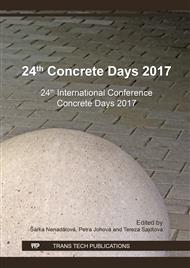p.82
p.88
p.94
p.102
p.107
p.115
p.121
p.127
p.135
Effect of SNCR on the Properties of Fly Ash in Terms of its Applicability to Concrete
Abstract:
At the beginning of 2016, the legislation for regulating and reducing the emission of exhaust gases with regard to reducing nitrogen oxides came into force. The articles published to date point to the possibility of increased ammonium salt content in fly ash that has undergone a selective non-catalytic reduction process. This paper addresses other possible negative impacts of the reduction process for nitrogen oxide on the physico-mechanical properties of high-temperature fly ash, especially the morphology of its grains and its impact on the rheology of the composite and the impact on the efficiency index.
Info:
Periodical:
Pages:
107-114
Citation:
Online since:
February 2018
Authors:
Keywords:
Price:
Сopyright:
© 2018 Trans Tech Publications Ltd. All Rights Reserved
Share:
Citation:


